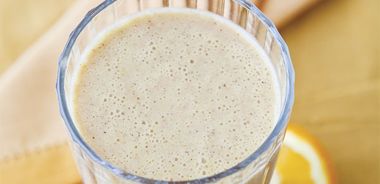Carrot Orange Smoothie

Here’s a smoothie that Bugs Bunny would go crazy for. Enjoy it when in need of a quick breakfast or an after-workout recovery treat. Ricotta cheese adds richness and protein, but you can also use plain Greek yogurt.
2 cups (500 mL) coconut water
1 medium carrot, chopped
1 orange, peeled and quartered
1/2 cup (125 mL) reduced-fat ricotta cheese
1 tsp (5 mL) minced fresh ginger
2 Tbsp (30 mL) almond butter
1/4 tsp (1 mL) allspice
1 frozen chopped banana
Place all ingredients into blender in order listed. Blend until smooth, about 1 minute. Divide among serving glasses.
Serves 2.
Each serving contains: 288 calories; 9 g protein; 13 g total fat (3 g sat. fat, 0 g trans fat); 39 g total carbohydrates (23 g sugars, 7 g fibre); 388 mg sodium
Electrolyte it up
With rigorous physical activity comes sweating, and with sweating comes a loss of electrolytes (sodium, potassium, calcium, and more). While many people replenish their electrolyte stores with sugary sports drinks, a natural option exists: coconut water. Boost your electrolyte levels with this Carrot Orange Smoothie, which contains not only thirst-quenching coconut water, but also protein-packed ricotta and almond butter, and carbohydrate-rich carrot and orange, all post-workout essentials.
source: "Colour Your Plate", alive #367, May 2013





